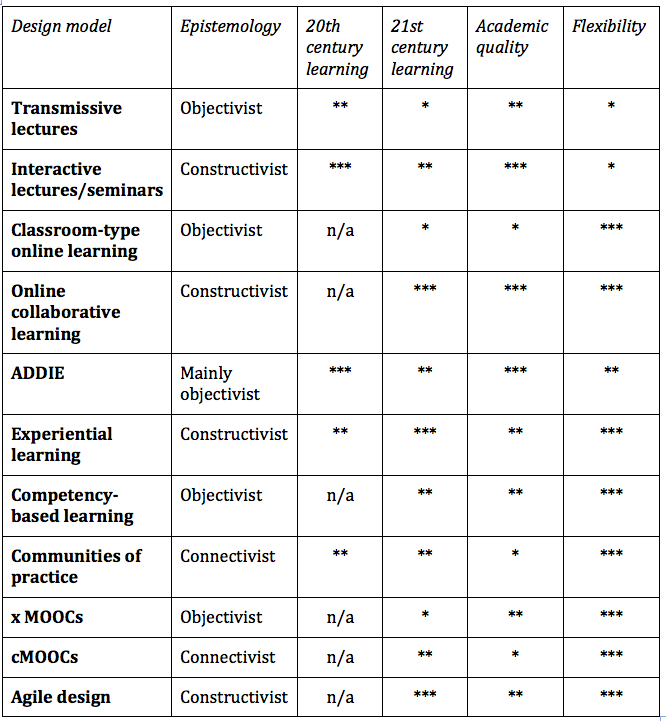37

4.8.1 Choosing a method
Chapters 3 and 4 cover a range of different teaching methods and design models. There are many more that could have been included. I will be discussing open pedagogy in Chapter 11, Section 4. MOOCs are also a notable omission. However, the design models behind MOOCs require a full chapter of their own (Chapter 5.)
Your choice of teaching method and the design of the teaching within that method will depend very much on the context in which you are teaching. However, a key criterion should be the suitability of the method and/or design model for developing the knowledge and skills that learners will need in a digital age. Other critical factors will be the demands of the subject domain, characteristics of the learners you will likely be teaching, the resources available, especially in terms of supporting learners, and probably most important of all, your own views and beliefs about what constitutes ‘good teaching.’
Furthermore, the teaching methods covered in Chapters 3 and 4 by and large are not mutually exclusive. They can probably be mixed and matched to a certain degree, but there are limitations in doing this. Moreover, a consistent approach will be less confusing not only to learners, but also to you as a teacher or instructor.
So: how would you go about choosing an appropriate teaching method? I set out below in Figure 4.8.2 one way of doing this. I have chosen five criteria as headings along the top of the table:
4.8.1.1 Epistemological basis
What epistemology does this method suggest? Does the method suggest a view of knowledge as content that must be learned, does the method suggest a rigid (‘correct’) way of designing learning (objectivist)? Or does the method suggest that learning is a dynamic process and knowledge needs to be discovered and is constantly changing (constructivist)? Does the method suggest that knowledge lies in the connections and interpretations of different nodes or people on networks and that connections matter more in terms of creating and communicating knowledge than the individual nodes or people on the network (connectivist)? Or is the method epistemologically neutral, in that one could use the same method to teach from different epistemological positions?
4.8.1.2 Industrial (20th century) or digital (21st century)
Does this method lead to the kind of learning that would prepare people for an industrial society, with standardised learning outcomes, will it help identify and select a relatively small elite for higher education or senior positions in society, does it enable learning to be easily organised into similarly performing groups of learners?
Alternatively, does the method encourage the development of the soft skills and the effective management of knowledge needed in a digital world? Does the method enable and support the appropriate educational use of the affordances of new technologies? Does it provide the kind of educational support that learners need to succeed in a volatile, uncertain, complex and ambiguous world? Does it enable and encourage learners to become global citizens?
4.8.1.3 Academic quality
Does the method lead to deep understanding and transformative learning? Does it enable students to become experts in their chosen subject domain?
4.8.1.4 Flexibility
Does the method meet the needs of the diversity of learners today? Does it encourage open and flexible access to learning? Does it help teachers and instructors to adapt their teaching to ever changing circumstances?
Now these are my criteria, and you may well want to use different criteria (cost or your time is another important factor), but I have drawn up the table this way because it has helped me consider better where I stand on the different methods or design models. Where I think a method or design model is strong on a particular criterion, I have given it three stars, where weak, one star, and n/a for not applicable. Again, you may – no, should – rank the models differently. (See, that’s why I’m a constructivist – if I was an objectivist, I’d tell you what damned criteria to use!)

It can be seen that the only method that ranks highly on all three criteria of 21st century learning, academic quality and flexibility is online collaborative learning. Experiential learning and agile design also score highly. Transmissive lectures come out worst. This is a pretty fair reflection of my preferences. However, if you are teaching first year civil engineering to over 500 students, your criteria and rankings will almost certainly be different from mine. So please see Figure 4.8.2 as a heuristic device and not as a general recommendation.
4.8.2 Design models and the quality of teaching and learning
Lastly, the review of different methods indicate some of the key issues around quality:
- first, what students learn is more likely to be influenced by choosing an appropriate teaching method for the context in which you are teaching, than by focusing on a particular technology or delivery method (face-to-face or online). Technology and delivery method are more about access and flexibility and hence learner characteristics than they are about learning. Learning is affected more by pedagogy and the design of instruction;
- second, different teaching methods are likely to lead to different kinds of learning outcomes. This is why there is so much emphasis in this book on being clear about what knowledge and skills are needed in a digital age. These are bound to vary somewhat across different subject domains, but only to a limited degree. Understanding of content is always going to be important, but the skills of independent learning, critical thinking, innovation and creativity are even more important. Which teaching method is most likely to help develop these skills in your students?
- third, quality depends not only on the choice of an appropriate teaching method, but also on how that approach to teaching is implemented. Online collaborative learning can be done well, or it can be done badly. The same applies to other methods. Following core design principles is critical for the successful use of any particular teaching method. Also there is considerable research on what the conditions are for success in using some of the newer methods or design models. The findings from such research need to be applied when implementing a particular method (this is discussed further throughout the book, but specifically in Chapter 12);
- lastly students and teachers get better with practice. If you are moving to a new method of teaching or design model, give yourself (and your students) time to get comfortable with it. It will probably take two or three courses where the new method or design is applied before you begin to feel comfortable that it is producing the results you were hoping for. However, it is better to make some mistakes along the way than to continue to teach comfortably, but not produce the graduates that are needed in the future.
There are still two major teaching methods to be discussed, Open Pedagogy in Chapter 11, Section 4, and MOOCs, which needs their own chapter (next).

Activity 4.8 Making choices
Describe your main subject area and level. Then try to answer each of the following questions:
1. What are the main learning outcomes (at a high level) that I need to achieve in this course or program, if the students are to be properly prepared for the future?
2. What teaching method is most likely to enable me to help learners achieve these outcomes?
3. How much would I have to change what I’m doing now, and what would the course or program look like in the future? Could I write a scenario to describe how I would be teaching in the future? Or how students will be learning in my course or program?
4. What support am I likely to get from my institution, in terms of supporting my ideas, supporting change, providing resources such as training in new methods, or professional help such as instructional designers?
5. How will my students react to the changes I’m contemplating? How could I ‘sell’ it to them?
No feedback is provided on this activity; it is for your personal reflection.
Key Takeaways (Chapters 3 and 4)
1. Traditional classroom teaching, and especially transmissive lectures, were designed for another age. Although lectures have served us well, we are now in a different age that requires different methods.
2. The key shift is towards greater emphasis on skills, particularly knowledge management, and less on memorising content. We need teaching methods for teaching and learning that lead to the development of the skills needed in a digital age.
3. There is no one teaching method or ‘best’ design model for all circumstances. The choice of teaching method needs to take account of the context in which it will be applied, but nevertheless, some methods are better than others for developing the knowledge and skills needed in a digital age. For the contexts with which I’m most associated, online collaborative learning, experiential learning and agile design best meet my criteria.
4. Teaching methods in general are not dependent on a particular mode of delivery; they can operate in most cases as well online as in class.
5. In an increasingly volatile, uncertain, complex and ambiguous world, we need methods of teaching that are light and nimble.

